Drink em' if you got em' - cannabis infused beer
There’s nothing like cracking open a cold one on a hot summer’s day or after a long day at work. Beer is something that we Canadians drink with pride and is ingrained into our identity. Heck – we love it so much we built a beer fridge that opens when we proudly say, “I am Canadian”. With the bubbly beverage being such a large staple in our lives, it only makes sense why the industry is booming. In just one year alone the Canadian beer industry went from 817 to 995 breweries; that’s a 21.8% increase from 2017 to 2018. To further instil beer into our Canadian identity, the industry saw a 0.3% increase in domestic beer sales while import sales declined by -3.4%. That left the entire industry seeing total beer sales as 85% domestic and 15% imported.
Recently, the team at Caddle conducted a survey asking 5,632 respondents about the beer purchasing habits. Let’s crack open these insights and see how they can contribute to the industry.
Cheap and Tasty
Turns out that consumers do care about the taste of their beer and don’t just drink it because everyone else does. When asking our consumers what is most important to them when purchasing beer, 48% of respondents said that taste and price are most important to their purchasing decision. With a 1.8% price increase in beer, maybe buck a beer isn’t such a bad idea after all as some may decide to purchase something else if the price doesn’t meet their budget.
There’s wine connoisseurs so why can’t there be beer connoisseurs? The same ol’stuff can start to taste bland and boring after a while. That’s what appears to have happened to Canadians in the 80’s as they realized there’s more than just Molson Canadian. Outside of Canada there were beers that had more taste and texture with other good qualities as well. This is arguably what started the development of craft beer market. If we’re good at drinking the stuff you darn bet we’re good at making it too!

A different kind of wobbly-pop
Since when did the younger generation start getting so responsible? When we asked our respondents what beer innovation they would be most interested in, we found that millennial males in Canada were most interested in cannabis infused beer.
Now, I know what you’re thinking – “that’s not responsible at all!” — but believe it or not, younger people are drinking less and looking for healthier options. They also want to be in control of themselves and not have embarrassing drunk stories told at their wedding in front of their new in-laws. Queue: cannabis infused beer. This innovation acts as an alternative in which cannabis is infused in a non-alcoholic beer where consumers can still get a buzz but feel more relaxed and in control of their actions.

Is that you cuz?
Cannabis and hops are actually distant cousins to each other (huh – learn something new every day eh?)! This is great news because if you’re a millennial male and you’re from Ontario, then you know that beer and cannabis go hand-in-hand with each other. Our survey results didn’t seem to shy away from this fact as millennial Ontarians were most interested in cannabis infused beer when compared to other provinces.
This is worth considering because due to the spike in the Ontario craft beer market, this leaves some left on their own with no future of success since there is simply starting to be too much competition to compete with. If you find yourself in this situation, perhaps cannabis infused beer is the answer. Millennials (especially Ontarian millennials) love the idea, so why not take a chance and see if you can start climbing the ranks to success?

IPA (Insights Provided Accurately)
We showed you the industry and our insights to go with it; so now what? It’s clear to see that the beer industry is a growing one and consumers are looking for more than their everyday kind of beer. They want something that comes at a good cost and taste. If you’re a beer advocate, than you know that beer is a big part of our Canadian identity and it’s fair to say that cannabis is as well, so why not give the people what they want and infuse the two in a socially acceptable beverage?
Caddle is a data insights company that works with a variety of organizations in the CPG industry who are looking to understand their consumers better. If you’ve got questions about your audience and how you can increase revenue, drop us a line and ask how we can help you.
[simple-author-box]
Egg consumption: Our data compared with the industry
The Egg Industry
Who doesn’t like waking up to the smell of bacon and eggs in the morning? Besides, breakfast is one of the most important meals of the day. Whether you have them for breakfast, lunch or dinner, eggs have been a staple in everyday Canadian lives. Recently, we surveyed our users asking them their purchasing habits when it came to eggs. After gathering the results from 7,481 respondents we found that 95% of shoppers purchase eggs while 77% of shoppers purchase eggs often. With a large majority of our users purchasing eggs this reflects well when comparing it to the egg industry itself. 2017 proved to be a profitable year as egg sales saw a 4.1% growth in Nielsen rating sales which was the second highest growth in the past 10 years. The Canadian government also reported a per capita disappearance (food available per person, per year) of 20.2 dozen eggs. The factors that have led to this increase in egg purchases is felt to be due to:
- Shift in consumer attitude toward eggs;
- Shift towards more protein driven diets with egg nutrition offering a cheaper protein source;
- Decrease in cold cereal food availability for breakfast;
- Increased demand for products containing liquid egg whites only, such as yolk-free omelettes and breakfast sandwiches

Let’s get crackin’
With the egg industry in Canada showing a progressive rise, we’re intrigued to see what our respondents want the most out of when purchasing eggs. Interestingly, 22.46% of millennial females in Canada indicated that they want cruelty-free eggs. This is something that the Egg Farmers of Canada (EFC) has taken into consideration. With the redevelopment of the national Animal Care Program, the EFC has worked to fast-track the implementation of new housing requirements which guide farmers and align their facilities with the standards of the Animal Care Program. These standards ensure that our egg laying friends are living with the basic needs such as shelter, adequate light and air, a well-balanced, nutritious diet, fresh water and clean surroundings.

What came first, the chicken or the egg?
In this industry – the chicken (sorry folks). Even though we know that our eggs came from the chicken, a lot of people want to know where their eggs came from. When asking our respondents which egg innovation they would most likely like, 34.44% of millennial women in Canada said that they would like locally sourced eggs. In their 2017 report, the EFC explained that in 2018 they will be printing an identifiable mark on the egg carton. This mark is in line with a new Egg Quality Assurance program which tells consumers that their eggs are produced by local Canadian egg farmers who are producing and have met the highest food safety and animal care standards. So now consumers can be reassured that when they see an egg logo with a checkmark and red maple leaf on their carton, their eggs are Canadian sourced and are of top quality.
White or brown eggs?
Whether they’re large, small, white, or brown all eggs taste the same. Which is likely why consumers aren’t necessarily loyal to one specific brand of eggs. When asking respondents what is most important to them when purchasing eggs, 63% of respondents said they base their egg purchases on price. Similarly, 76.25% of respondents said that they would purchase a different brand of eggs if their preferred brand was out of stock. This is intriguing when comparing the average cost of production and retail price of eggs over the years. The EFC reported that pricing trends in 2017 saw an increase in the average national COP and producer price of eggs while there was a decrease in the national retail price of eggs at $2.48 per dozen. This is something worth analyzing over the years as it might suggest that egg producers will have to make sure that there is an even balance between the COP, producer price and retail price as consumers have noted that they will purchase a different brand of eggs if it doesn’t meet their price range.

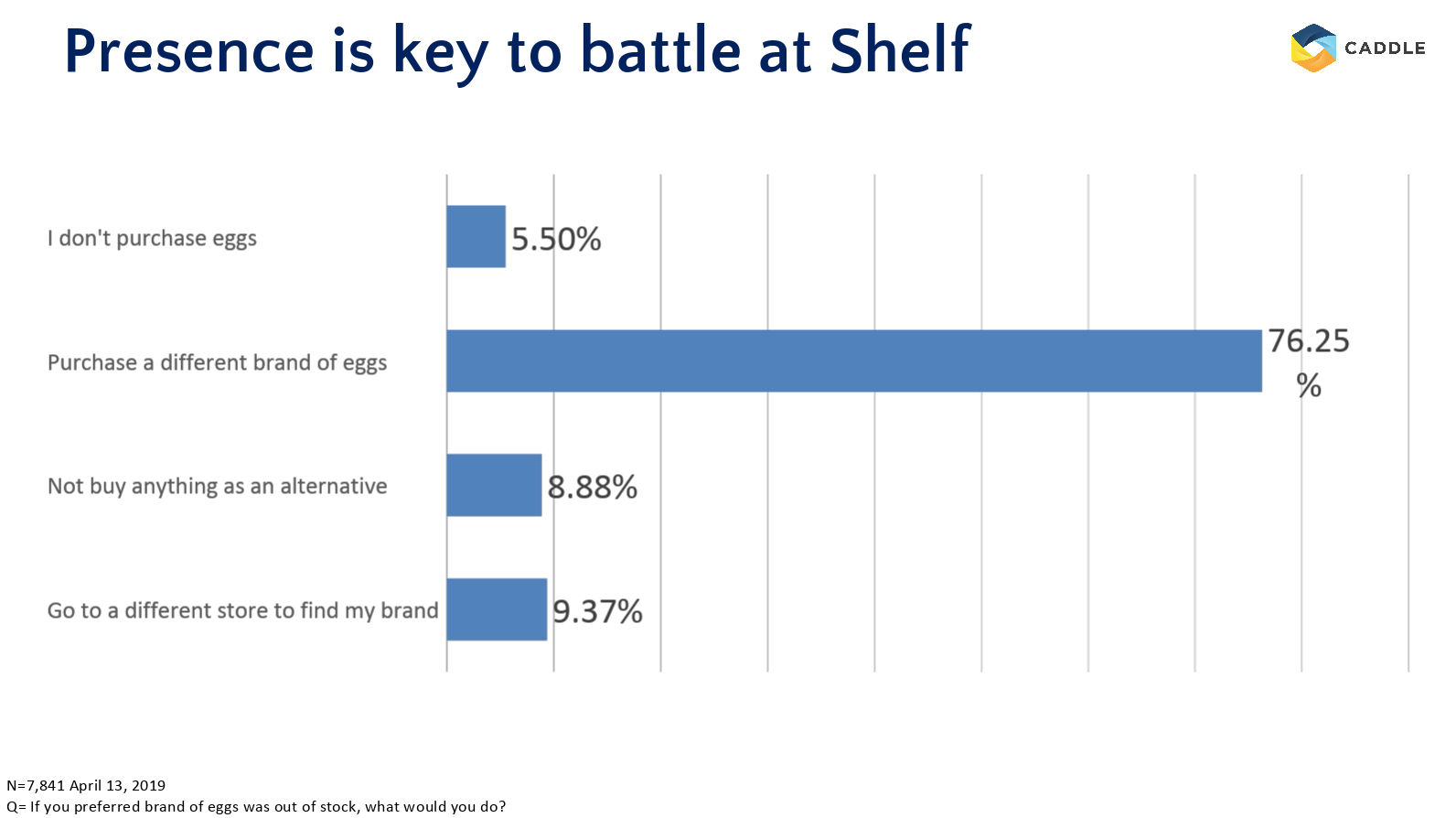
So what?
Caddle is a data insights company that is driven at understanding market and industry trends for the benefit of those in the industry. Our recent survey indicates that egg producers are meeting the wants and needs of consumers purchasing eggs such as providing appropriate living for hens, and informing consumers that their eggs are locally sourced. If you’re feeling scrambled with how you can increase the profitability of the industry you’re in, connect with Caddle to get the data insights you need.
[simple-author-box]
What trends are approaching the soup broth industry?
The Soup Market
Soup – it’s been a staple in our lives from the time we were children. A nice tomato soup accompanied with a grilled cheese, or a hearty bowl of chicken noodle to help fight off a cold. Soup has been around for generations and will continue to be a staple, allowing the opportunity for industry leaders to grow their market share, provided they understand their consumer’s behaviour.
The soup industry is one that has been around for a while with Campbell Soup Company and General Mills Inc. being the industry leaders. While IBISWorld reports a -2.8% decline in total revenue in the United States, as well as a soup sales decline in Canada to $699.9 million in 2017 from $709.4 million in 2012 (reports Financial Post), there has been a growth in the soup industry by 1.6% and projections show the market will have a compound annual growth rate of over 4% by 2024.
Hearty Data
Here at Caddle we conducted a survey asking over 10,ooo of our consumers their soup broth purchasing habits which we believe could help explain the current soup broth industry and forecast how it could be improved upon.
For starters, when we asked what is most important when purchasing ready to use soup broth, 35% of our members agreed that taste and flavour was the driving purchasing decision while there was an over-indexing score of 38% when targeting Gen Z consumers. This is interesting as global flavours such as Campbell’s introduction to Pho broth have become a popular choice. With the introduction of popular broths entering their product lines it’s also important to remember that “consumers want their food to be made with recognizable, desirable ingredients,” says Melissa Mendoza, director of marketing for Campbell Canada.
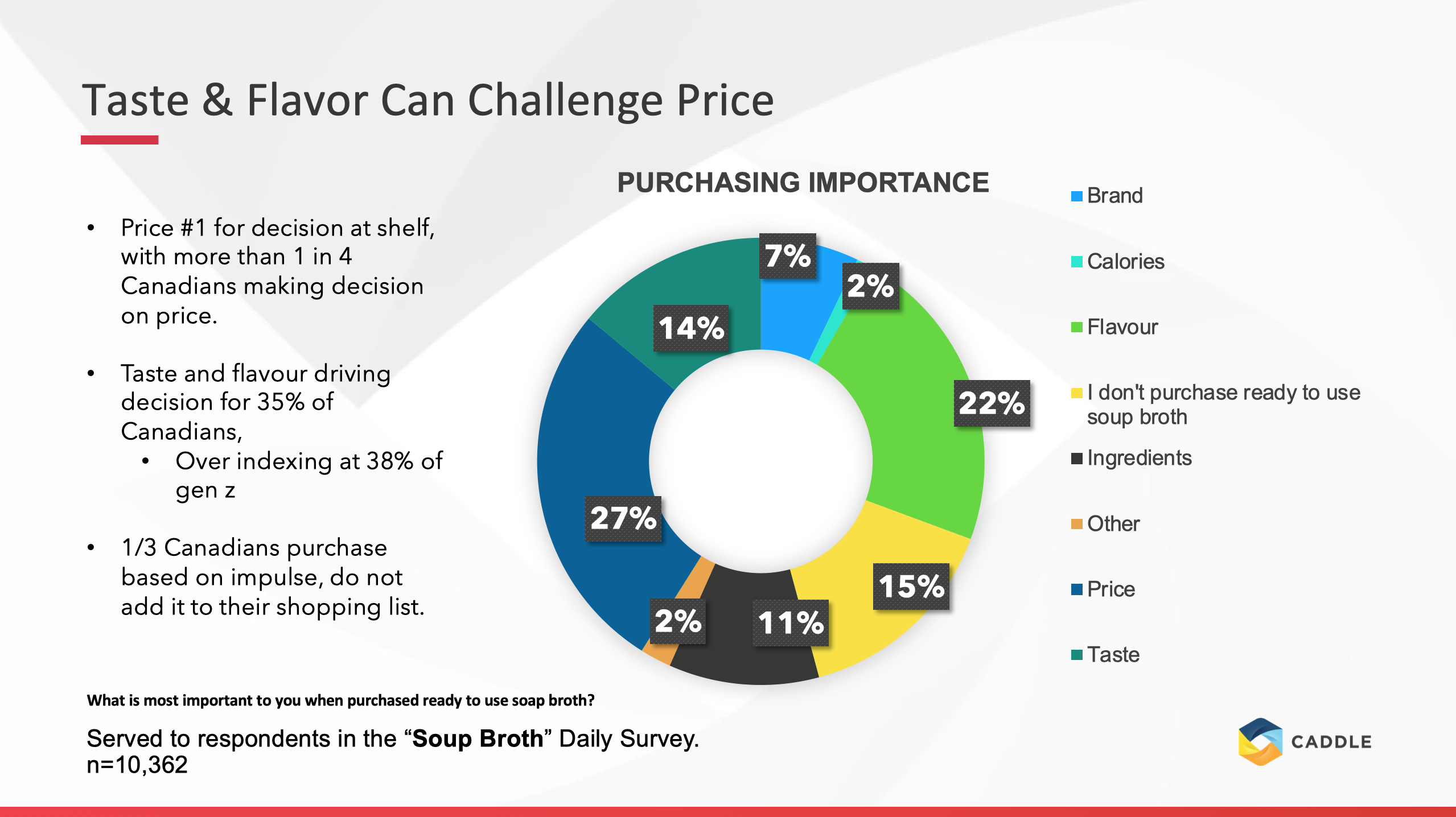
Soup Innovation
With the Millennial and Gen Z generations making their way to being the majority population, the soup industry may want to consider some newer innovations to increase revenue. To adhere to the demographics wants, Campbell’s has reduced sodium, added vitamin D to their condensed soups and only added ingredients that people can actually pronounce. While this is a step in the right direction to generating more revenue, our survey offers another innovation as well.
When presented with a list of options, we asked our members what product they’d most likely like to try and 30% of members said that they are interested in ready-to-drink chicken bone broth. While we thought this was surprising, after further research we found this data to be accurate when we discovered a +100 search intent on Google Trends. This new innovation is one that is on the rise in popularity for its collagen benefits, support in digestive health and arthritis relief. With a younger demographic wanting healthier options in their soup, perhaps bone broth is one innovation to consider.

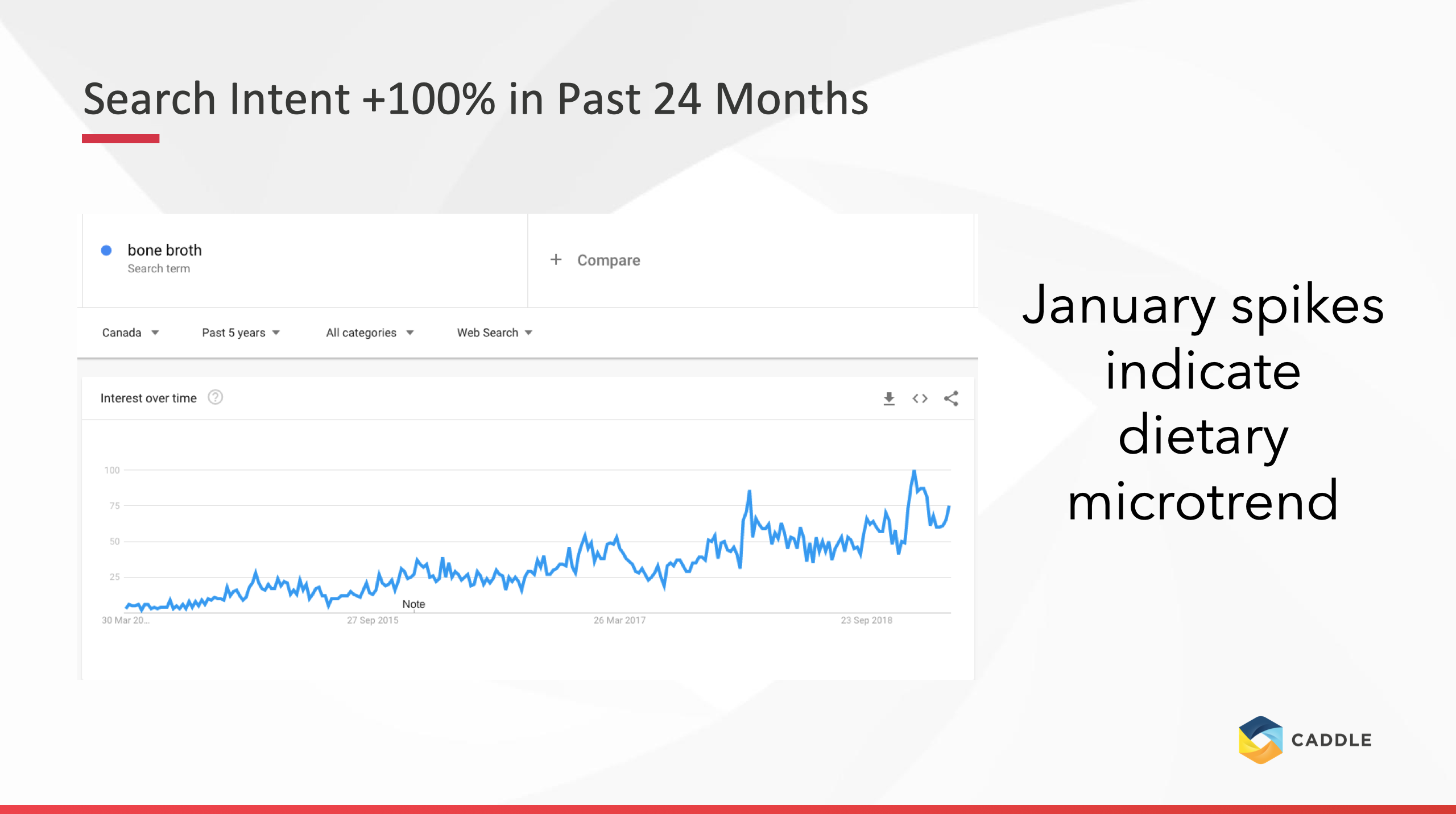
Brand Loyalty
When you think of a soup brand perhaps one of the first brands that come to mind is Campbell, Knorr, or Progresso. But much to our surprise, we found that 1/3 Canadians are loyal to their broth brands. So how might a company in the industry increase brand loyalty? For starters, since the soup broth market projected to increase over 4% by 2024 this offers the opportunity for new entrants to be entering into a lucrative industry. On the other hand, this could also create significant competition between industry leaders and new entrants. Therefore in order to generate brand loyalty, it may be important for production companies to consider creating healthy broth alternatives such as lower sodium broths or ready-to-drink bone broth.
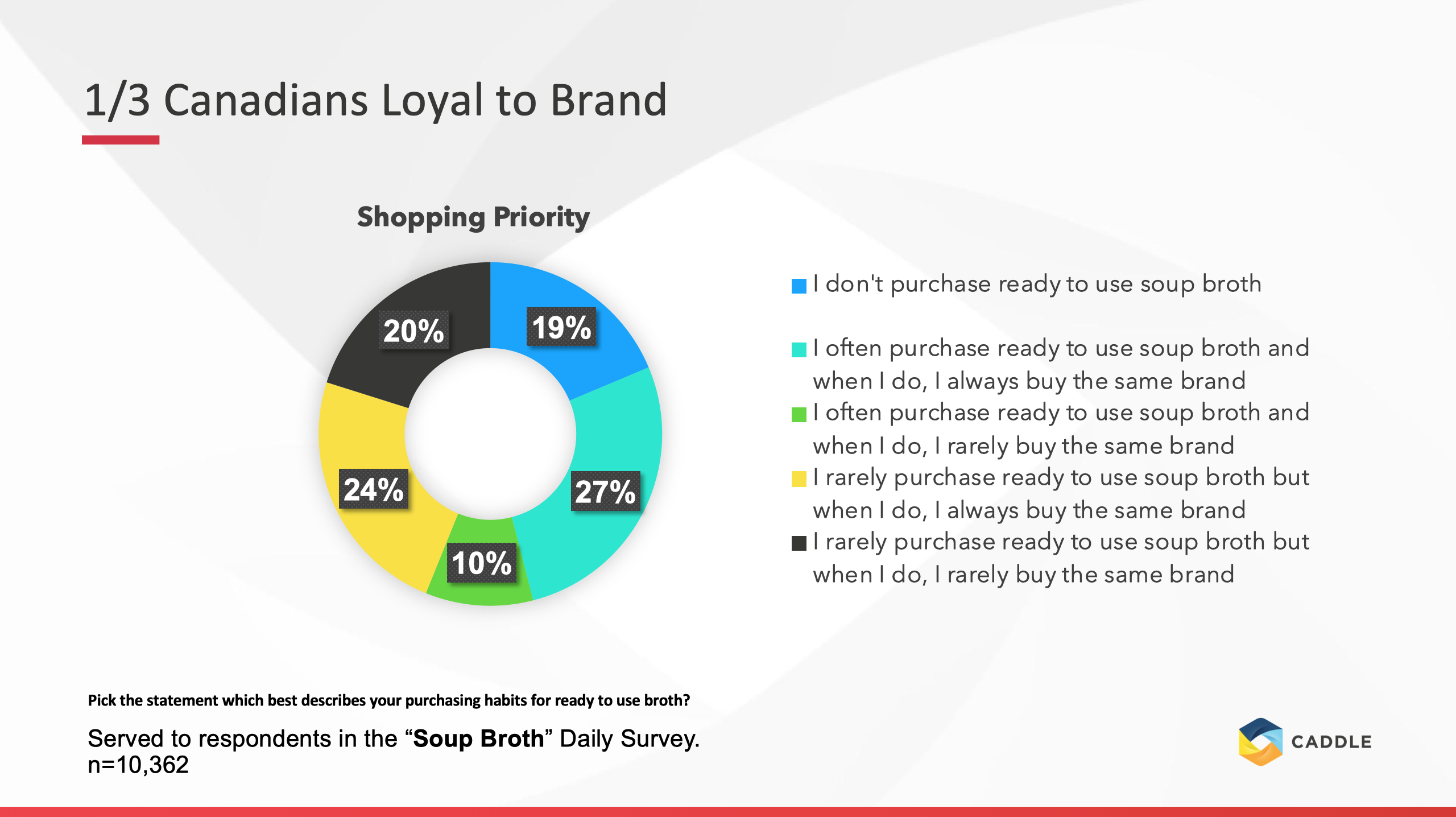
Now What?
Soup has been our lives since as long as we can remember, everyone loves a good soup and sandwich. But no one likes working in an industry that doesn’t know their demographics wants and needs. That is where Caddle steps in. We provide industry leaders with insights that will help them understand market trends and how they can increase revenue and brand loyalty. If you’re a soup broth industry, our insights suggest that there should be a continued effort to create broths that are flavourful and healthy. By creating a flavourful broth that attributes to the health trends such a bone broth, this could allow for the potential for consumers to regularly buy the product and in turn, increase brand loyalty.
[simple-author-box]
Price, taste and innovation: what's in your breadbasket?
The Bread Market
We all have a love for bread (maybe a little too much), and the global trends certainly appear to reflect that as the global bread market was valued at $201 billion USD and is showing no signs of a plateau in the coming years. Diving a little further into that figure and zeroing in on our homeland, Canada’s bread production industry has a collective of $8 billion CAD while showing an annual growth rate of 2.4%. While this is a flourishing market both globally and continently, recent market trends seem to show that consumers are looking for more healthy options as to avoid looking too doughy themselves. This would encourage the production of more nutritious, specialty and artisanal breads.
The Facts
This is all very interesting to us as some of these trends appear to correlate with our survey findings. When asking consumers to select a statement that best describes their bread purchasing habits we found that 95% of people buy bread (I know, shocking right?). But as anticlimactic as this might seem, this is actually very intriguing considering the steady rise of bread (pun intended). When observing the market trends with regard to the price of bread, the prices are now 70.39% higher since 2000 with an average inflation rate of 2.84% per year; meaning that a loaf that would normally cost $5 in 2000 would now cost $8.52 in 2019. But what does this mean for the industry leaders? Well you better make sure that your brand is on the shelf because 66.88% of people said that they would purchase a different brand of bread if the one they normally purchase wasn’t available. Similarly this could mean consumers aren’t entirely loyal to their normal brand of bread and if there is a cheaper option available they could be likely to put that one in their basket instead.
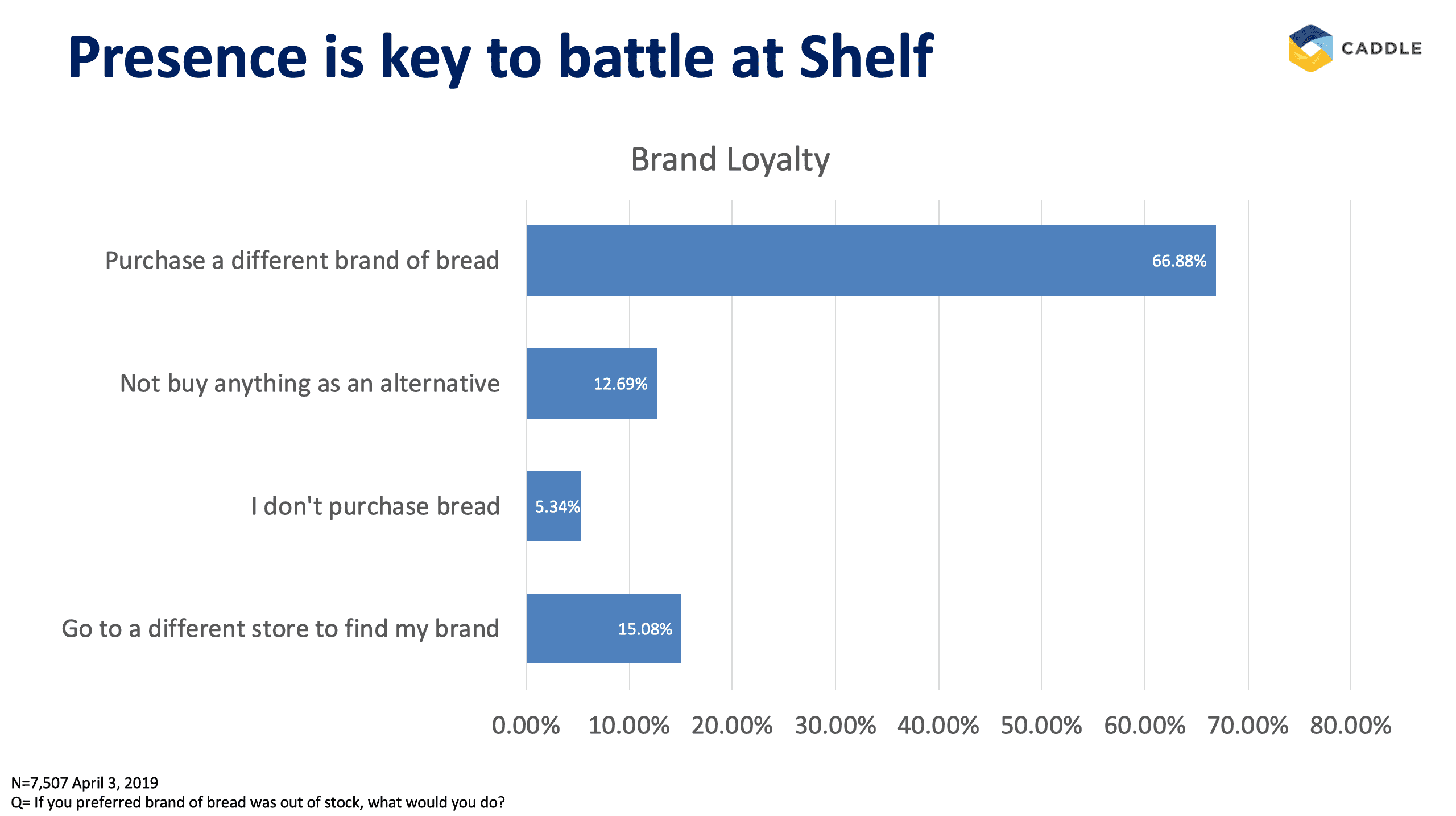
The best invention since sliced bread
Who doesn’t love new innovations? They make our lives easier without even realizing that the normal way of doing things was problematic. When it comes to bread there is nothing more frustrating when you’re making the dream sandwich only to find out that your delicious bread is moldy and you’re forced to throw out the bread. Food waste has become a real issue with reports of 1/3 of food produced goes to waste and equates to $1 trillion wasted globally. Comparably, our survey results indicate that millennial females are most interested in purchasing half loaves of bread. While this innovation isn’t a solution to all food waste, it’s certainly one that is plausible as half loaves have been available in the European market for quite some time. To further this idea, our Ontario demographic stated that 1 in 4 females would be interested in purchasing half loaf bread. This appears to align with market trends as Supermarket News states that while bread remains a staple, people are consuming less of it. Perhaps by then having the option to purchase half loaves of bread could help contribute to the prevention of food waste and align with the trend that bread just isn’t being consumed in the same quantity anymore.

Great taste at the right price
It’s fair to say that every purchase we make we want the most bang for our buck. So why should we have to sacrifice taste for the price of bread or vice versa? That’s something that struck with our respondents. 59% of our users said that their bread purchases are based on the price and taste. This again correlates with the research done by Supermarket News as they found that two-thirds of their respondents stated that price is the most important attribute when purchasing bread while taste placed second with 57% of respondents citing taste as the second most important attribute when purchasing bread. As much as we love the smell, taste, and comfort bread brings to us, it still seems to have a negative image due to its health aspects. With the high levels of carbs, sodium and fat levels “operators have had to scramble to keep up with changing fads like low-calorie, whole grains, artisanal and gluten-free [breads]” says Supermarket News. For industry leaders knowing what consumers want such as well priced, tasty and healthy products, this is the daily bread that keeps the company ahead in the market.
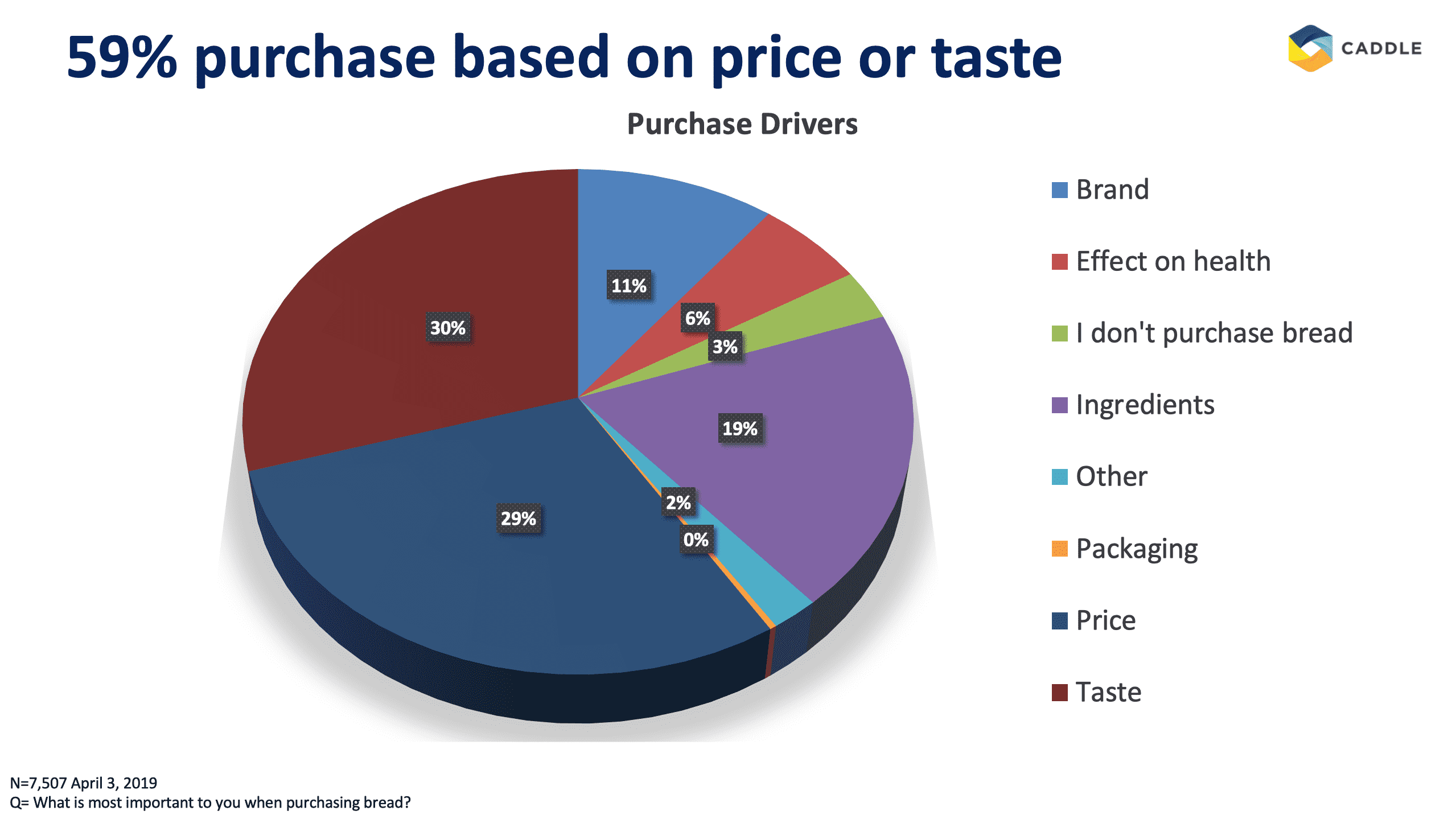
So what?
Based off of our results from respondents, we can see that a large majority of consumers are purchasing bread but there are certain aspects that determine their purchasing habits. Consumers want bread that is well priced, tasty, healthy and quantifiably efficient. Aside from half loaf of bread, our Canadian consumers also reported that they are interested in innovations such as high protein bread and Canadian sourced ingredients. From the quick survey that we had our consumers respond to, it’s evident to note that our findings align with current market trends. That is why we strive and have the passion to work with market leaders to help them understand their consumers purchasing behaviours in order to increase the industry leaders revenue and brand loyalty.
Who Are We?
If you’re unsure by now, Caddle is a data insights company that has a passion for understanding market trends which can be translated to the market industry leaders for the benefit of understanding the buying behaviours of their consumers. Most recently Caddle conducted a survey with a sample size of 7,507 respondents in which we asked consumers their buying decisions when it came to bread. Given today’s market trends, we found the results to be quite interesting and we hope you do too.
[simple-author-box]
Why I choose St. Catharines for Caddle
Why I chose St. Catharines
Four years ago, I had just quit my full-time marketing job to establish and launch Caddle. While we could have chosen Toronto or any of the cities within Hamilton or the GTA, we’ve never wavered from knowing that St. Catharines, Niagara is home.
Making the choice was easy because we want to see St. Catharines thrive. For myself and many of our management team, our decision was personal; we have roots in Niagara and want to be part of its success as it becomes a major contender in Canada’s digital economy.
Here are a few reasons I continue to choose St. Catharines:

Source: Wikimedia
1. Access to high-quality talent and lower startup costs
Four years in, I’m still often shocked by what’s here. If we can’t find the talent we need right in St. Catharines, it’s in Grimsby or another of Niagara’s municipalities. We chose Niagara as our home for the region’s lower cost of living, beautiful natural wonders, high quality of life, and arguably easier access to talent. The cost to launch is lower here, too – a huge plus when you’re a founder of a small startup looking to establish a home base. If we’d located in Toronto, we would have at least quadrupled our burn rate with the increase in costs.
In contrast, Niagara offers the best of both worlds – a growing region, it’s just far enough (about an hour and a half) away from hectic mid-Toronto traffic but close enough that we can jump on the QEW and zip up to the big city when we need to. Plus we now have the daily GO train going right into Union!
While Toronto’s talent pool may be 50 times larger than Niagara’s, there are 100 times more companies in Canada’s largest city competing for top employees. In terms of high-quality talent per capita, I feel we’re in a better position here.
Caddle is thriving and continues to grow. In Toronto, we’d have been one of a million promising startups. In St. Catharines, we’re a big fish in a small pond. We attract highly talented web developers, marketers, Customer Experience and IT staff, and more.
2. Exceptional quality of life and sense of community
Our employees love the short, easy commute as well – Brian Cline, our Head of Technology, lives in Niagara Falls and commuted to Etobicoke for years. Now, he has about a 20-minute drive to work.
Most of our staff live within a 15 to 20-minute drive, which means they can spend more time with their families and less time facing the gridlock of GTA traffic every day. I walk to work in about seven minutes and often bring my dog, Maya, in with me. We find that our staff love the community they live and work in. They’re also invested in our long-term success and are passionate about helping to build a positive, dynamic company culture.
From the first day, I’ve always stressed the importance of family, flexibility, and work-life balance. Because our employees tend to stick around, they enjoy a lot of trust and flexibility within our team, which makes for a happy, productive work environment.
If you’ve got an important appointment to attend or a can’t-miss recital for your kid, you can take time off and do that here in Niagara (which is essential – happy families mean happy people!) We always say that no matter where you are in the region, for the most part everything you’ll need – schools, food and entertainment, shopping, outdoor spaces like parks and hiking trails, the gym – is within a 30-minute drive. This all contributes to high employee satisfaction, low turnover rate and great work-life balance.

Source: Instagram
3. Government funding and support
While access to talent is a critical factor, so is funding and support. There are also unique opportunities for funding. For example, we’ve gained access to funds from federal and provincial levels of government looking to fund outside of the GTA.
As for local support, there’s Innovate Niagara, a business incubator and one-stop shop for the region’s entrepreneurs for intensive workshops, training and educational and networking events. The team there have been critical to our success, from walking us through incorporation to legal advice and hiring employees. They are one of many organizations, agencies, and companies playing a role in building our flourishing tech community.
When I knocked on their door, I had an idea, but I didn’t know how to turn it into an app. I didn’t know how to incorporate or where to find local talent. We’ve been with Innovate Niagara for more than two years, eventually joining their incubator at 1 St. Paul Street in downtown St. Catharines. We’re currently both located a few blocks from there, in the same building at 43 Church Street. Within our first three months, they’d connected me with legal resources, given me names of three local web developers, and introduced me to their executives in residence. They also provided access to mentorship, coaching, and funding for an early public relations campaign.

Source: Innovate Niagara
Wrapping up
Today, I love contributing my time to Niagara’s entrepreneurial community by speaking at events and participating on panels where I can promote Niagara.
Bonus: Doing this also helps me meet people working on amazing projects, and to develop as an entrepreneur. I’m still learning from our team, consumers, and the wider community every day, and don’t see that slowing down any time soon.
The future looks bright. We’re confident in the leadership at city hall and wholeheartedly believe in Mayor Walter Sendzik’s vision for the future. With the right programs, opportunities for incubation and the right incentives, St. Catharines (and Niagara as a whole) will be at the forefront of innovation. I look forward to the day when Caddle is just another of the many digital pioneers who saw Niagara’s potential in its early stages.
Demographics and loyalty in the workplace
Demographics and loyalty in the workplace
There are many reasons why living in Canada is so desirable: access to healthcare, education, our abundance of fresh water and beautiful nature – even employment. In fact, Canada continues to show a downward trend in unemployment year to year. Statistics Canada reports that in January 2018, Canada’s national unemployment rate was down to 5.9% from 6.8% in January 2017.

This positive trend in the workforce is not necessarily as beneficial for employers, however. Earlier this year, The Globe and Mail reported that 89% of Canadian employees are prepared to leave their current job for “the right offer,” up from 78% in 2014.
Analyzing employment trends, the Caddle team decided to ask Canadians if it’s okay to apply and interview for jobs, even if there is no intention of leaving a current position.
The majority of Millennials (29%) and Generation Z (31%) considered it completely acceptable to apply for other jobs, compared to the majority of Generation X (29%) considering it only somewhat acceptable, and Boomers (33%) considering this not at all acceptable.

When it comes to interviewing for a job you have no interest in taking, however, all four generations shared more similar views. The majority of Millennials (28%) and Generation Z (31%) considered this action only somewhat acceptable, while the majority of Generation X (30%) and Boomers (43%) considered this to be not at all acceptable.
There’s another split when it comes to gender as well – particularly around interviewing for a job despite being happily employed. The majority of men (28%) deemed this completely acceptable, while the majority of women (32%) deemed this not at all acceptable.
There are positives to applying and interviewing for jobs even if you’re happily employed: it’s valuable practice, an opportunity to expand your professional network and it’s a chance to get a better sense of where you stand compensation-wise. If you decide to apply or interview for another job, though, avoid letting it affect your day-to-day responsibilities, and always be careful not to burn bridges with either party.
How can employers stay competitive in a cash-driven culture?
Caddle Survey
In a recent survey of 10,000 Canadians, Caddle found that the majority of the workforce chose their current job for its better salary over their previous job (24% of Millennials and 23% of Generation X).
It appears that employers are recognizing this cash-driven culture and responding accordingly to attract new talent. In their 2018 Salary Guide, Export Development Canada (EDC) reports that 40% of employers are willing to break salary guidelines to recruit new hires, and offer 15% over expected salary to attract highly skilled professionals. EDC aptly points out that this approach is problematic, however, as the same 3,500 hiring managers EDC surveyed showed a continued trend toward offering less than 3% salary increases to existing employees. This results in a growing number of people willing to move jobs, up to 90% in 2018 from 75% in previous years.

With increasing expectations around salary and an aging population, how do Canadian employers stay competitive when hiring and attract top talent?
Human resources (HR) platform Pro Sky recommends focusing on developing a positive work environment, considering candidates with potential (i.e., over experience to date) and focusing on coaching and mentoring opportunities. Providing recognition and understanding work-life balance are other key assets.

HR consultant Sharlyn Lauby of HR Bartender suggests establishing a solid employee referral program, giving candidates a realistic job preview, and considering boomerangs (former employees who can return with fresh perspective and skills). Sharlyn also recommends focusing on the application and interview process, making it easy to apply and training hiring managers to interview well.

The BC Tech Association challenges employers to reduce response time and rounds of interviews, as top talent – especially in the tech industry – won’t necessarily stick through the whole process anymore.
Most importantly, EDC reminds employers to take care of the employees they already have before anything else.
Exploring travelling in Canada by car
Exploring travelling in Canada by car
In a Caddle survey taken this year, 90% of Canadians confirmed that they would recommend travel to Canada – and it looks like the world agrees. According to Statistics Canada, the number of U.S. tourists rose by 3.1% from 2016 to 2017, reaching 14.3 million in 2017.
If you’re inspired to see all Canada has to offer, here are just a few of the destinations you can reach by car from our many border crossings:

Alaska
If you’re driving through the Alcan border crossing:
· Yukon Wildlife Preserve (Yukon) – 5 ½ hours
o Miles Canyon (Yukon) – additional 30 minutes
o Emerald Lake (Yukon) – additional 30 minutes
· Nahanni National Park Reserve (Northwest Territories) – 16 hours
Washington and Idaho
From the Blaine border crossing:
· Whistler (BC) – 2 ½ hours
· Pacific Rim National Park Reserve (BC) – 6 hours
From the Eastport border crossing:
· Yoho National Park of Canada (BC) – 4 hours
Montana and North Dakota
Crossing from Sweetgrass:
· Dinosaur Provincial Park (Alberta) – 2 ½ hours
· Cypress Hills Interprovincial Park (Saskatchewan) – 3 ½ hours
· Banff National Park (Alberta) – 4 ½ hours
· Jasper National Park (Alberta) – 6 ½ hours
· Wood Buffalo National Park of Canada (Northwest Territories) – 17 ½ hours
Crossing from Raymond:
· Prince Albert National Park (Saskatchewan) – 6 ¼ hours
Crossing from Dunseith:
· Riding Mountain National Park (Manitoba) – 2 ½ hours

Michigan, New York and New England
Entering Canada from Detroit:
· Bruce Peninsula National Park (Ontario) – 5 ½ hours
Entering Canada from Niagara Falls:
· Algonquin Provincial Park (Ontario) – 3 ¾ hours
Entering from the Chateauguay border crossing:
· Ottawa (Ontario) – 2 ½ hours
· Mont Tremblant (Quebec) – 2 ½ hours
Entering from Jackman:
· Quebec City (Quebec) – 2 hours
From Fort Kent:
· Kouchibouguac National Park (New Brunswick) – 4 ¼ hours
Crossing at the Calais border:
· Fundy National Park (New Brunswick) – 2 ¼ hours
· Green Gables Heritage Place (PEI) – 4 ¼ hours
· Prince Edward Island National Park (PEI) – 4 ¼ hours
· Peggy’s Cove Lighthouse (Nova Scotia) – 5 ½ hours
· Skyline and Cabot Trails (Nova Scotia) – 7 ½ hours
Travelling from the Houlton crossing:
· Gros Morne National Park (Newfoundland and Labrador) – 19 hours
· St. John’s and Signal Hill (Newfoundland and Labrador) – 25 hours

Provincial and Territorial tourism sites
travelyukon.com
spectacularnwt.com
nunavuttourism.com
hellobc.com
travelalberta.com
tourismsaskatchewan.com
travelmanitoba.com
ontariotravel.net
quebecoriginal.com
tourismnewbrunswick.ca
tourismpei.com
novascotia.com
newfoundlandlabrador.com
How to achieve work-life balance
How to achieve work-life balance
Today, Millennials are approximately 22 to 37 years old, while those from Generation X are roughly 38 to 53 years old. With this age difference, many might expect priorities to differ when it comes to the workplace, but a recent Caddle survey reveals that the two generations actually share almost identical priorities at work. Both generations prioritize work-life balance first (31% Millennials, 30% Gen X), followed by respectful treatment (21% Millennials, 22% Gen X) and the opportunity to help others (15% Millennials, 13% Gen X).
If you aspire to achieve greater work-life balance, here are tips on steps you can take on both professional and personal fronts:

At work
At risk of getting an infamously catchy song stuck in your head, your key mantra should be to “let go.” Forbes recommends letting go of the pursuit of perfection, and proposes the idea that quantity over quality in the workplace may be better for the soul.
Both Forbes and Mayo Clinic encourage you to delegate more; Mayo Clinic further adds that you should say “no” more often – this will help you prioritize, manage your time more accurately, and therefore perform at a higher rate. Mayo Clinic also provides sage advice around email management: reduce email checkpoints to three times daily (late morning, early afternoon and late in the day) – this allows you to start your day by prioritizing your individual tasks and challenges, not those around you.
While it may seem counterintuitive, asking for help, delegation, and saying “no” are all signs of professional growth – these same habits that help achieve work-life balance are also milestones that your manager is likely looking for in your development.

In life
While it may be cliché, there is so much truth to the saying that “health is wealth.” While it may seem nearly impossible with everything going on at work, making time to exercise and eat healthfully are fundamental factors to achieving work-life balance.
Another important factor in improving personal health and professional performance is proper sleep. Harvard Business Review makes the case for getting quality z’s and provides tips on how to do so.
Whichever steps you choose to take toward a better work-life balance, remember to start small.
